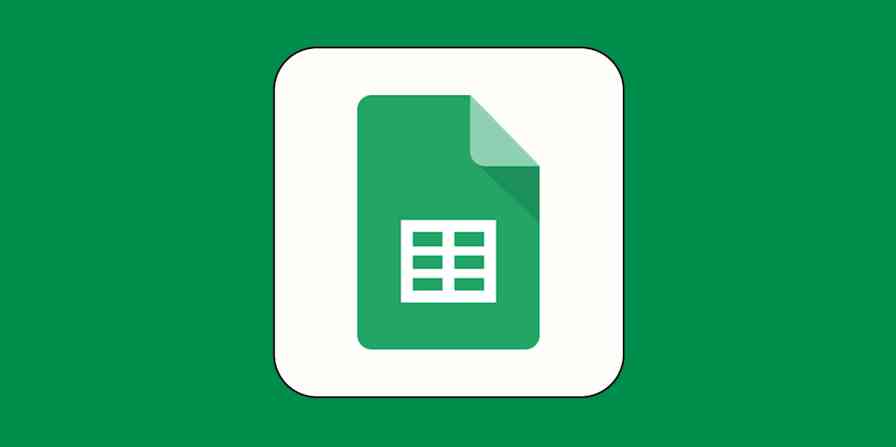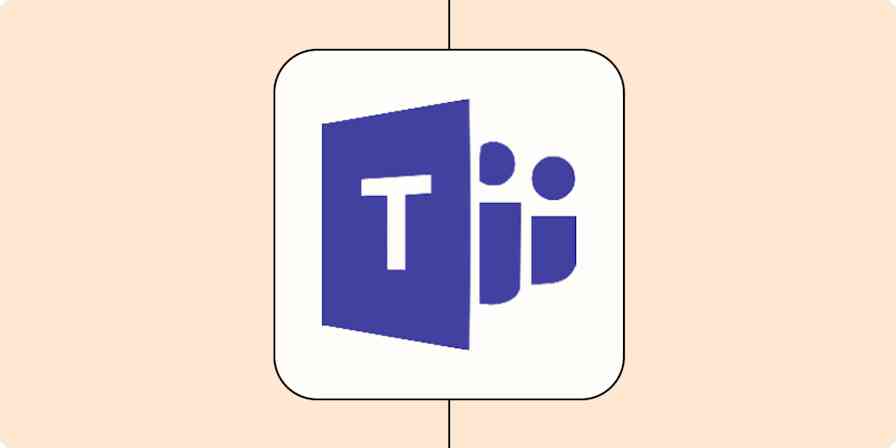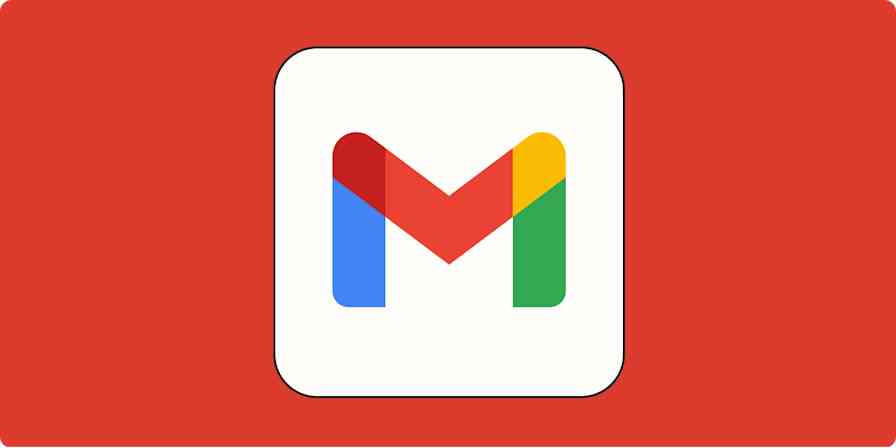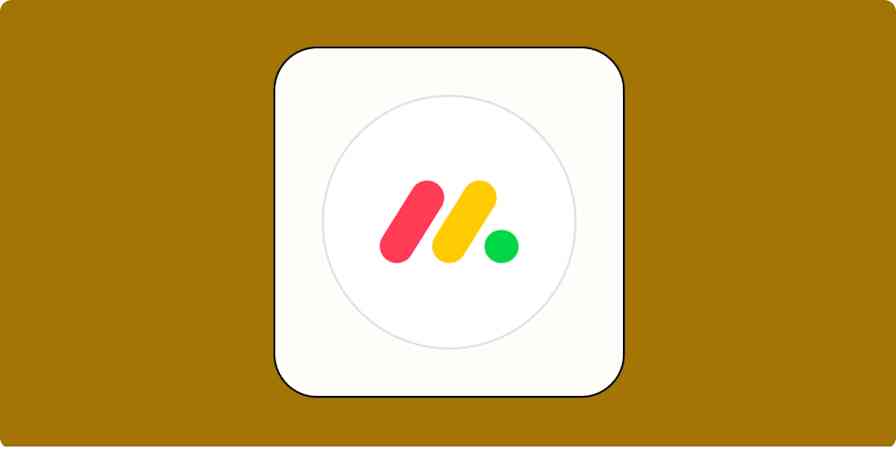Writing authentic sales emails is tough, even for the sharpest salespeople. It's hard to continuously come up with fresh and creative ways to talk to prospects in a way that won't get you sent straight to the trash.
So I thought I'd run a little experiment. I fed ChatGPT a whole load of different prompts to see if it could craft some decent sales emails for me.
As you can imagine, this involved a lot of trial and error. The bot returned some nice email content but a lot of garbage too. Some of the emails would never even be opened by a prospect, let alone convince them to have a call with you.
So rather than fire hundreds of sales email AI prompts at you (which, let's be honest, you could just ask ChatGPT to do), I've taken a different approach. Instead, here are six tried-and-tested ChatGPT prompts that generated sales emails that are actually usable.
1. ChatGPT prompt for cold outreach emails
Sending a cold sales email to someone who doesn't know anything about you or your company is the hardest of all messages to get results from. How do you convince someone out of the blue that they desperately need something they've probably never even thought of before?
To start things off, I tried a really simple and straightforward prompt: "Write a cold email to a sales lead." It didn't work, and honestly, it was a good lesson on how not to write prompts. Here's what ChatGPT generated:
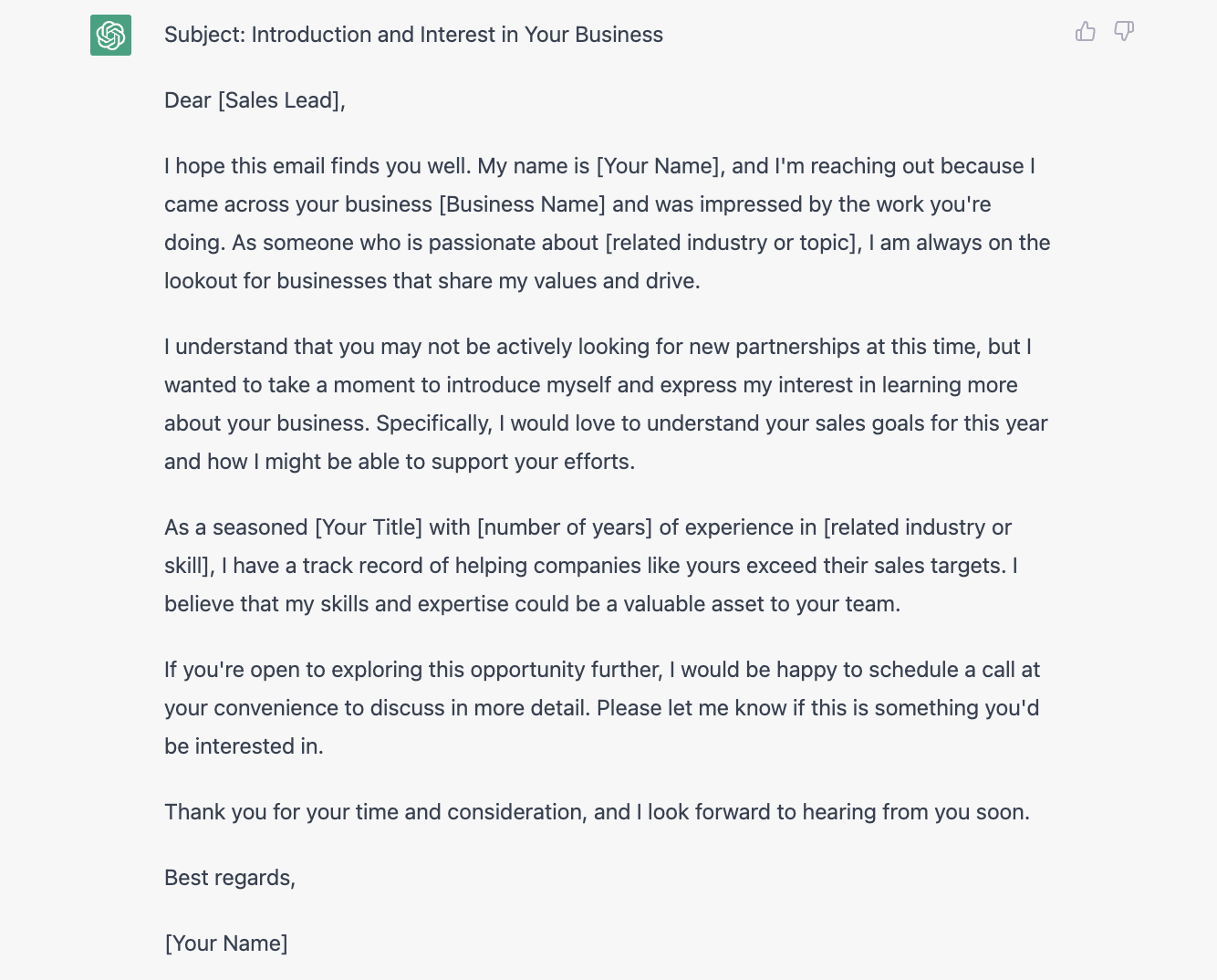
The first thing that immediately jumped out at me was how long the email is. When you're sending a completely cold sales email to a stranger, you need to keep it short. You also want to sound at least vaguely human. This email is really formal and reads like a robot wrote it (imagine that).
Capitalizing your subject lines is also really formal and comes across quite strained. It gives the impression you think you have Something Extremely Important To Say. But ironically, it sends the opposite signals.
So, I added a couple of stylistic words to the prompt to see what impact that would have:
"Write a concise and informal cold email to a sales lead."
And here's what came back:
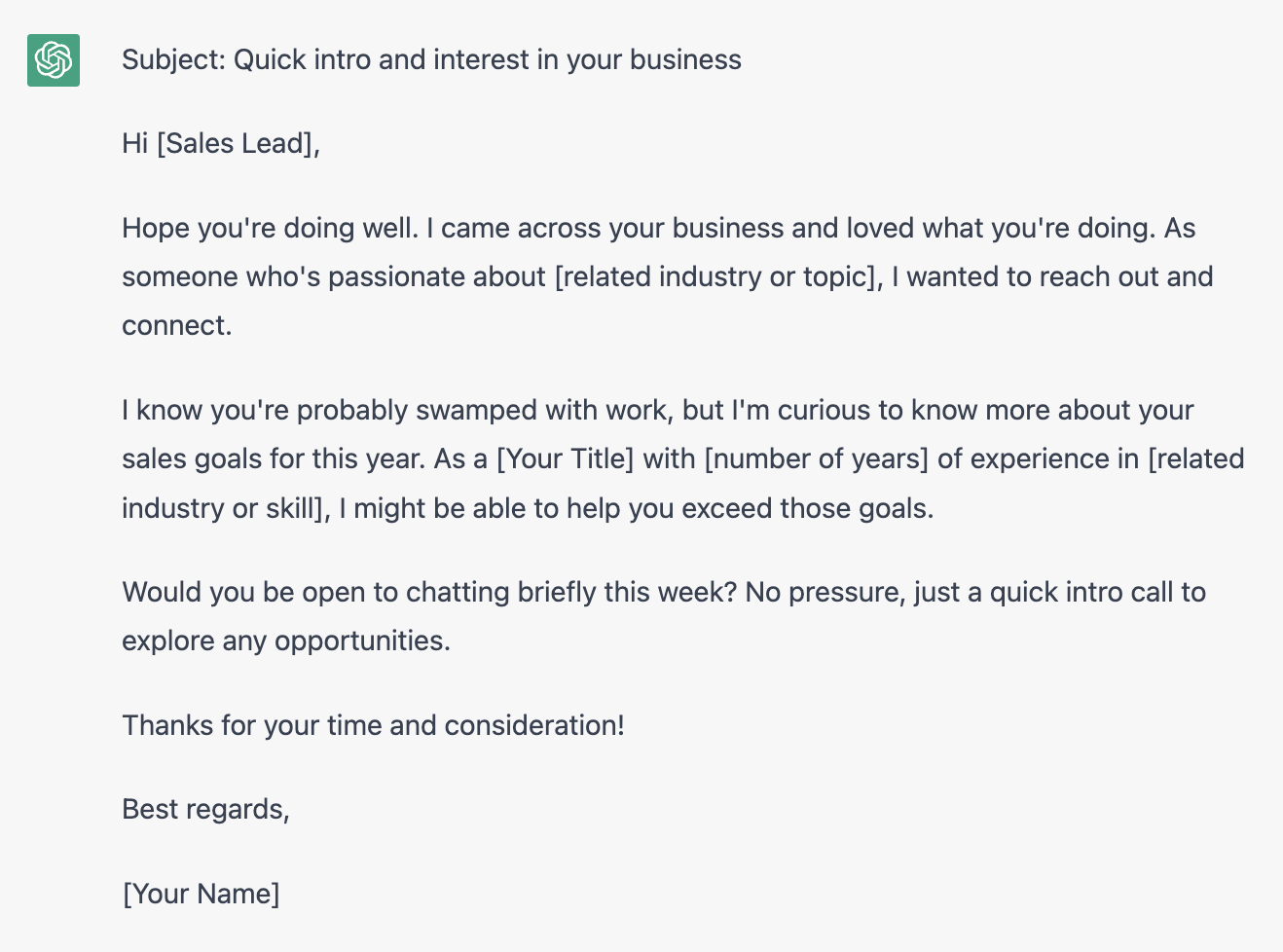
This version isn't perfect. Phrases like I "loved what you're doing" and calling yourself "someone who's passionate about" the industry isn't going to convince anyone. You'd need to edit those parts to make them more specific. But it's miles better than the first one.
Adding those extra stylistic prompts to make the email "concise" and "informal" has definitely improved the email. The important thing is, it reads like a human wrote it, not a robot. I can hear the person's voice in my head as I read it—and that's way more engaging. And check it out: this prompt didn't generate a subject line in title case either.
To personalize the email even more, you could add in specifics about the person you're writing to—if there's enough publicly available information about them, ChatGPT will fill in the blanks it left in the original template, and even add some other nice details.
2. ChatGPT prompt for sales prospecting emails
Writing sales prospecting emails to warm leads is all about specifics. As a warm lead, the prospect should already know who you and your company are for one reason or another, and you should know them and their challenges pretty well, too.
So for this email prompt, I created a new chat window in ChatGPT so that I could train the bot to get to know the prospect a bit better.
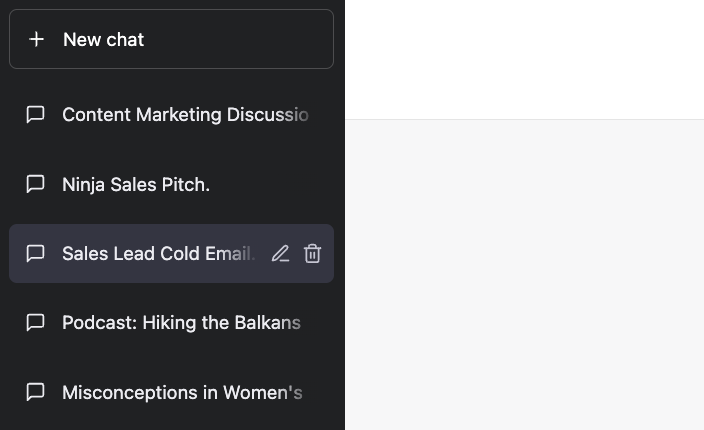
The prompt that brought the best results for me was:
"As [your name and company/ industry], write an introductory warm sales email to [prospect name] from [prospect industry and company name]."
Here's an example of what I got:
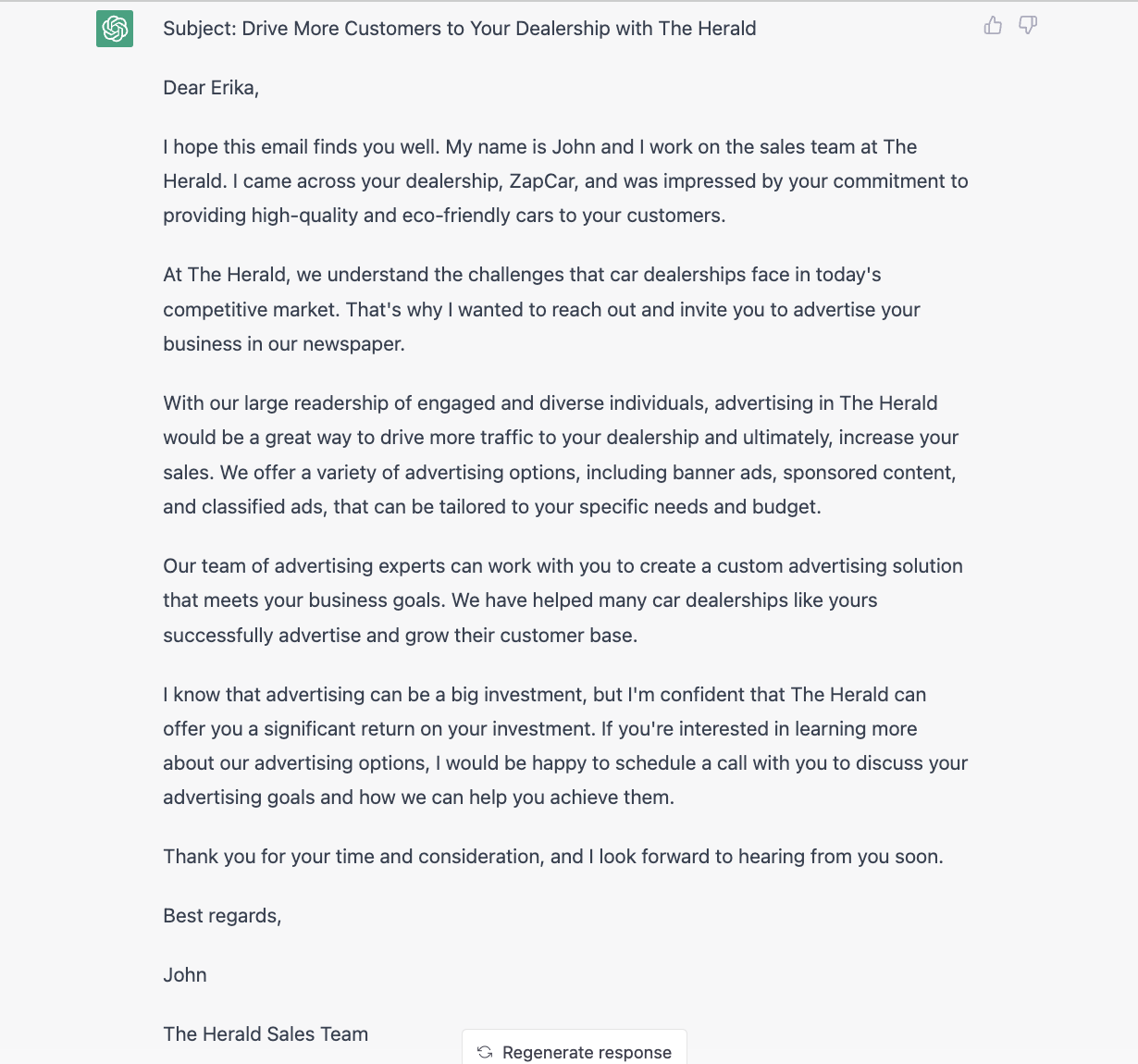
To show you how much detail I added here, this is the exact prompt I used: "As John from The Herald newspaper, write an introductory warm sales email to Erika from used car dealership ZapCar."
The subject line, "Drive more customers to your dealership" was pretty smart (even if it was in title case, but I'll shut up about that now). The email also proposed a few different advertising options even though I had provided no context around what The Herald's advertising options even were.
ChatGPT works best when you give it more context, so don't hesitate to copy in the information you have about your prospect and their company (assuming it's all public information).
3. ChatGPT prompt for LinkedIn prospecting emails
For most of us, LinkedIn is still the best place to look for sales leads. You might not necessarily reach out to someone on the platform directly, but it's a great place to find relevant leads, especially if you work in B2B sales.
Sifting through a whole load of LinkedIn profiles and sending individual, personalized messages to each prospect is time-consuming. But with the right prompt, you can let ChatGPT do a large chunk of the leg work for you:
"Katie's Linkedin summary: [copy LinkedIn summary] Write a cold email to Katie, who I just found on LinkedIn"
When testing this one, I used my own LinkedIn summary. I did this because I wanted to see how convinced I would genuinely be as a prospect if I was approached by someone using this ChatGPT prompt.
I have to say, I was pretty impressed with the result:

If I'm being brutally honest, this email is better than half the messages I currently have sitting unanswered in my LinkedIn mailbox.
Although some parts of the email are a bit stiff and impersonal, it's pulled out some highlights from my LinkedIn that would convince me that they've read my profile and that I am indeed a good match for whatever their project is. For example, it mentioned my areas of specialty and the fact that I work freelance and remotely.
Creating a hyper-personalized email like this is just a matter of copy/pasting the prospect's LinkedIn summary into the chat and letting the algorithm do the hard work for you.
4. ChatGPT prompt for follow-up emails
Follow-up emails aren't necessarily difficult, but they're usually boring: you're just regurgitating a lot of what's already been said. But they're necessary: they serve as a paper trail for both parties to have clarity on the next steps you've agreed on.
Because ChatGPT has a good memory, you should create a fresh chat window for any lead you're working on, so it can remember any specifics you've fed it about context. Then you can jump back into that chat window whenever it's time to follow up, and it will pick up where you left off. To create a follow-up email, you won't have to explain the details about your prospect all over again.
Here's the best prompt I came up with for a follow-up email with my fictional prospect Erika from ZapCar:
"Write a 100-word follow-up email to [prospect name] who I've just had a call with and is now ready to [action]."

For this example, I tried asking it to write a "concise" follow-up email, but it didn't really work. Because it remembered so much previous detail about Erika, the email was still way too long. I had to be more precise about how long a concise email was, so the bot understood the parameters.
When I added in "100-word email," the output was much more straightforward and didn't get bogged down by the details.
Adding in the "action" at the end of the prompt also totally transformed the email. For this example, the action was that Erika was "ready to place a banner ad in The Herald." This meant the action became the focus of the email and the subject line. ChatGPT also nicely weaved in some next steps that were clearly relevant to the process.
5. ChatpGPT prompt for a sales email to someone who's ghosting you
When a prospect is ghosting you, the worst thing you can do is barrage them with dull "Just checking in!" emails. Any email that exists simply to bump yourself up the prospect's inbox will almost certainly get ignored.
I tried a whole load of different options for this one, and most of them were shockingly bad or just downright shocking. This was the prompt that brought the best results:
"Write a concise, professional but funny sales email to a prospect who's ghosting me."
Adding a bit of humor to your last-attempt emails can help you take a final stab at standing out. Using the word "funny" in the prompt was a bit risky, but "professional" kept things more or less along the right lines. This prompt brought better results than I was expecting:
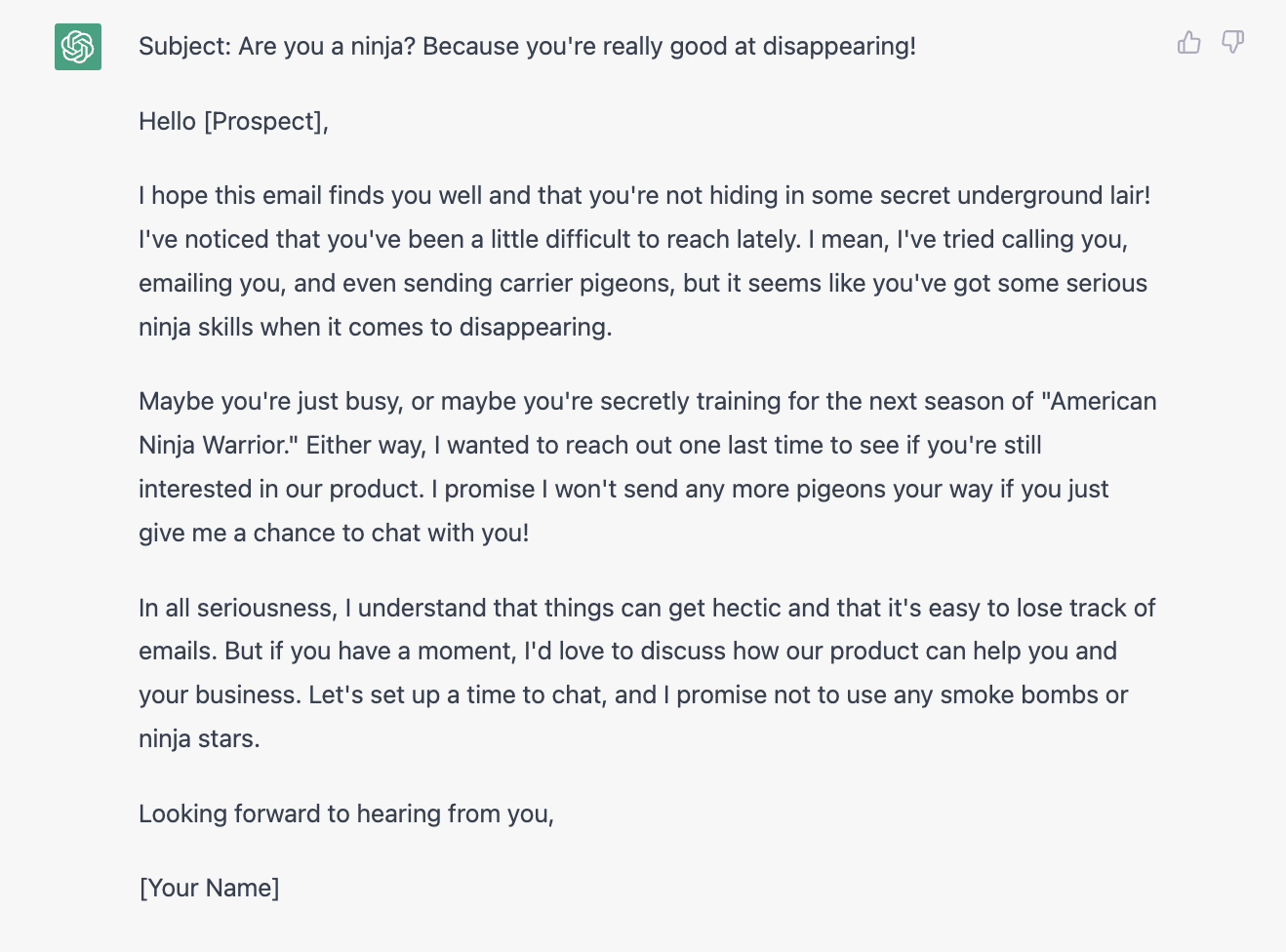
Obviously, this email needs some serious editing—it's a bit over the top, and it's not going to be right for every prospect. But talking about ninjas and carrier pigeons would at least stand out to me if my email inbox was busy, that's for sure. And if you change it to say something like "subtle humor," you'll get more toned-down results.
If you're not totally happy with the jokes ChatGPT comes up with, hitting the Regenerate response button will bring something new up. You can keep hitting the button until it tells a joke that makes you laugh. Or smile. Or at least feel something.
It's worth mentioning that calling this email a "breakup email," as it's normally called in the sales world, doesn't work in ChatGPT. The algorithm is "trained to decline inappropriate requests," and clearly it thinks that's what this is.

6. ChatGPT prompt for referral emails
Asking a customer for a favor when you've just managed to push them over the line can feel awkward and a bit opportunistic, which makes referral emails tricky to write. But there's no denying that referral leads are gold if you can get them.
I learned from Zapier's ChatGPT prompt guide that using "in the style of" in your prompts can be useful because the bot is good at matching up styles with information it has in its training model. It uses whatever examples it can find of that person's tone and voice to generate something close to what it thinks it would sound like.
"In the style of [well-known salesperson whose tone you like], write an email to a recent customer to ask for a referral."
So, I tried asking Sir Alan Sugar from The Apprentice to write my referral email to see how it looked:
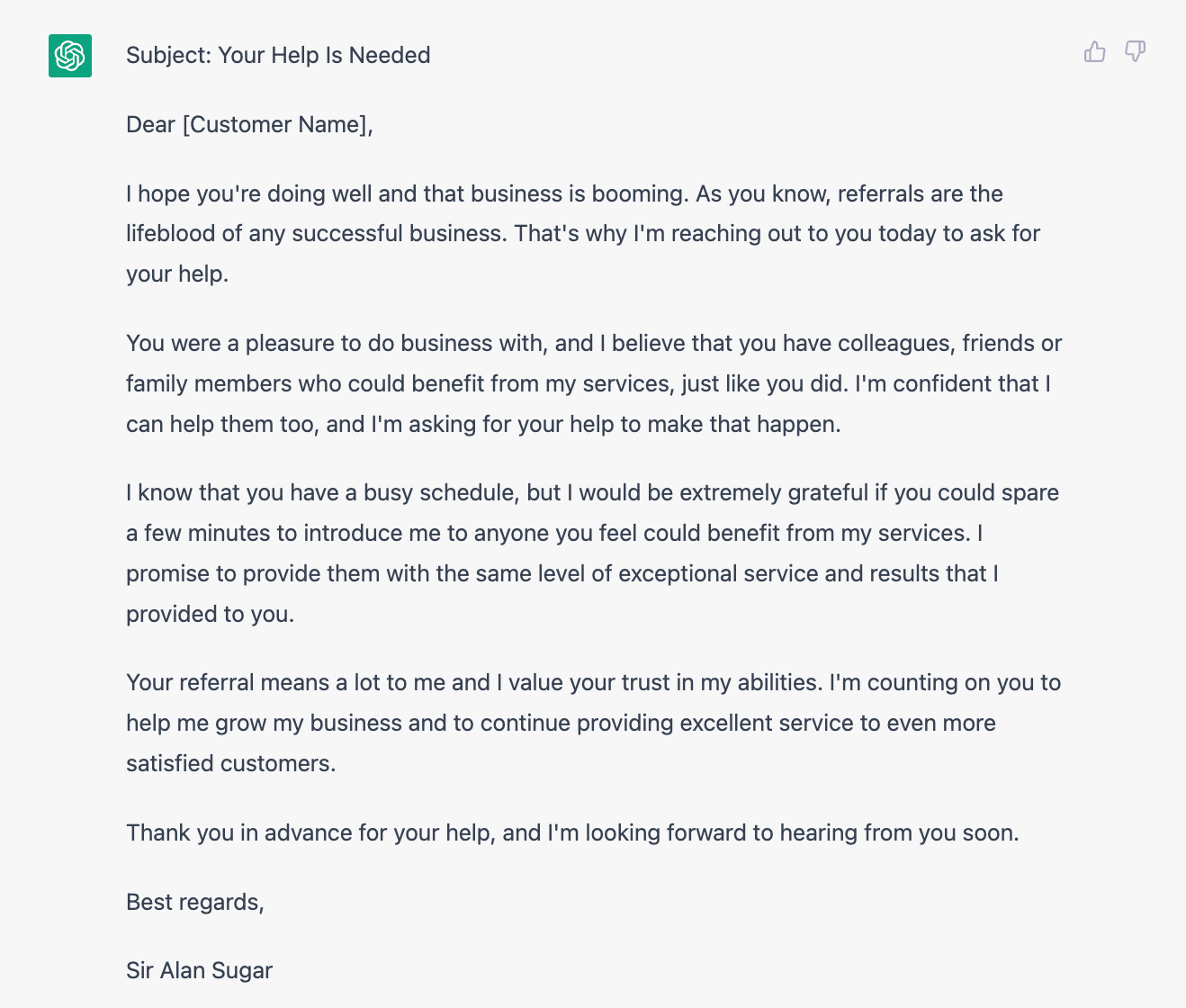
Out of interest, I tested this prompt out by switching Sir Alan Sugar with Bart Simpson:
Who knew Bart was such a good salesperson? This sales email made me laugh out loud, which isn't something that happens every day. It was interesting to see how well ChatGPT responds to this kind of prompt.
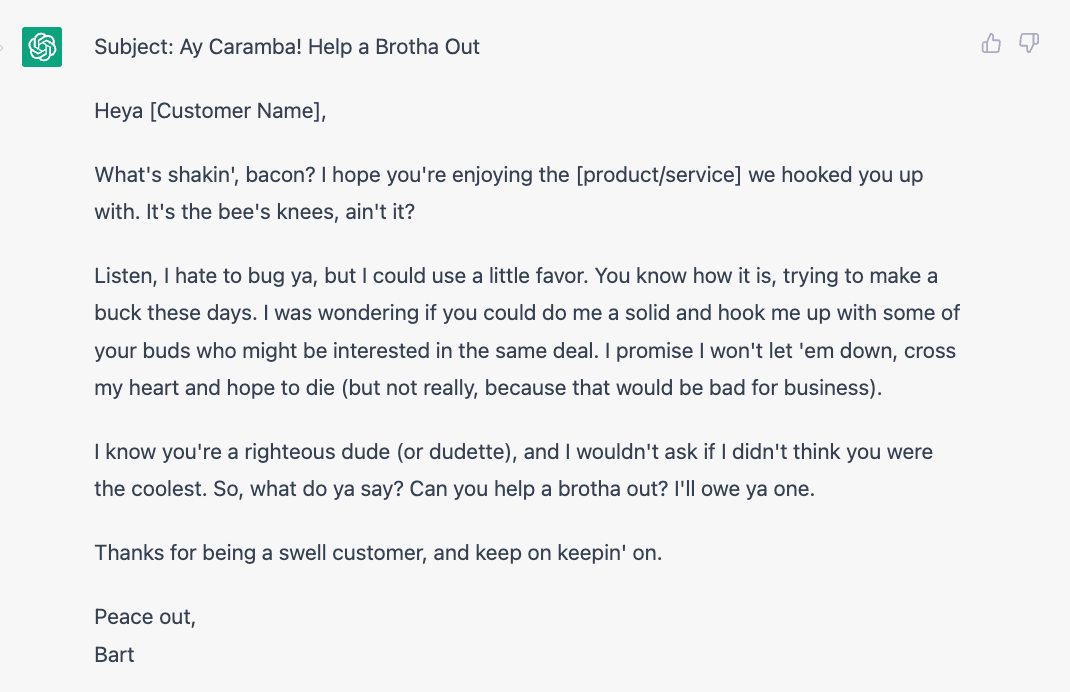
You could definitely test this out by swapping in a few different salespeople to see the kind of language it comes back with. But as always, it's important to use your judgment here: the Jordan Belfort way of selling won't get you anywhere in today's world. Except straight in the bin.
Tips for writing the best ChatGPT prompts for sales emails
After spending a good chunk of time testing sales email prompts, here are a few tips I picked up along the way:
Test out multiple versions. Don't settle on the results your get from the first prompt you fire into ChatGPT. There will almost always be a better, more refined answer, so try at least a few options until you come up with the best version. You can click the pencil icon on the right to edit your prompt, and then scroll back through previous versions by clicking the numbers on the left.

Always edit ChatGPT emails carefully before you send. You can't rely on ChatGPT to bring flawless results. You need to treat it as what it is: a robot.
Be as specific as you can with your prompts. If your prompts are too general, you'll get a basic and uninspiring output, which is the last thing you want when writing sales emails. If you provide more context, ChatGPT will provide better answers.
Use the Regenerate response button. At the bottom of the chat window, you'll see a Regenerate response button. It's always worth hitting that a few times, as ChatGPT will return slightly different answers.
Use descriptive words. Including descriptive words like "professional," "concise," or "funny" can have a big impact on the style of email the tool generates. Words like these work as signposts that tell ChatGPT what sort of tone you're looking for.
Create new chat windows for high-value clients. Creating individual chats for your important prospects will allow the bot to get to know the details of your most important leads. This will make it easier to create the most tailored communication it can from your prompts.
If you prompt ChatGPT with the same information and instructions every time you interact with it—e.g., "Write a concise and informal email to a sales lead from [your name]"—use ChatGPT's custom instructions feature to get the chatbot to automatically consider this when it generates a response. This way, you don't have to keep repeating the same instructions.
Automate your ChatGPT prompts
To save you from jumping over to ChatGPT every time you need to generate a sales email, you can use Zapier's ChatGPT plugin to automatically send ChatGPT outputs to wherever you send your emails, whether that's an email app, your CRM, or anything in between.
Want to know exactly how Zapier's ChatGPT plugin works? Check out our help doc for more information.
Related reading:

